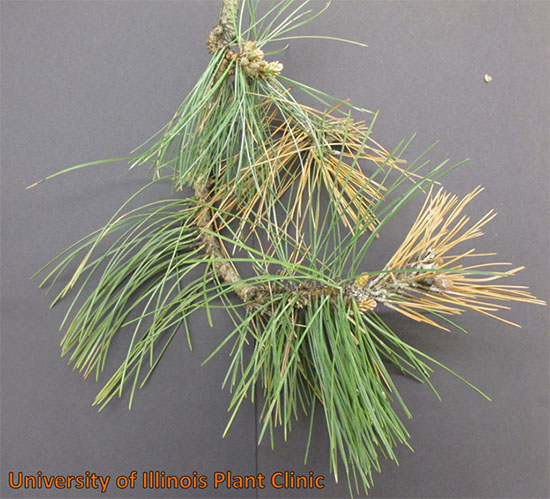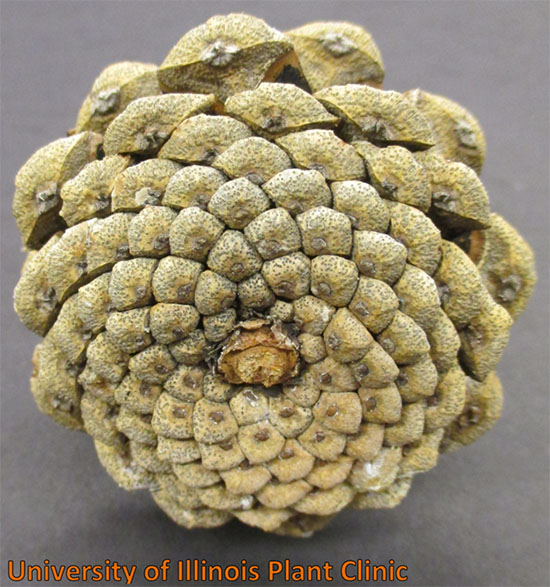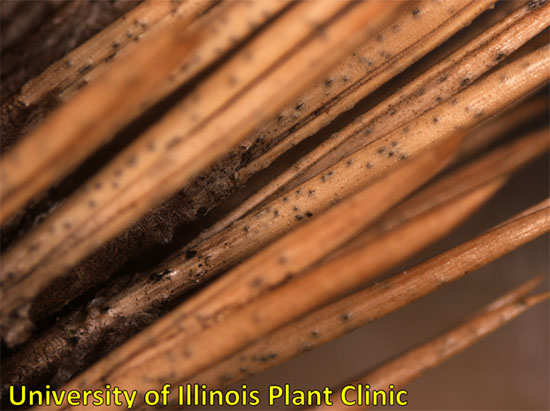Issue 4, May 18, 2015
Diplodia Tip Blight on Pine
The Plant Clinic has received a number of pine samples with various ailments this spring. Diplodia (also known as Sphaeropsis) Tip Blight has continued to be a common diagnosis on Austrian, Scots, and other pines. It can also affect spruce, fir, Douglas fir, cedar, arborvitae, and juniper plants, though the disease is much less common on these hosts. Diplodia Tip Bight is considered a stress disease because it is much more common on plants under stress. The pathogen is a fungus which causes both a needle blight and cankering of the branches leading to very ugly trees which, if the disease is allowed to continue for several years, may succumb.

Pine tree partially affected by Diplodia. As the fungal spores spread, the disease will begin to affect more of the tree. Photo credit: University of Illinois Plant Clinic.
Diplodia can be a bit tricky to diagnose in the field as there are a number of needle blights in Illinois and microscopic observation of spores is needed for a definite confirmation of the pathogen. However, there are some characteristic symptoms that are associated with the disease.
Tip Blight: As the name of the disease implies, Diplodia causes a blighting, or browning of new needles. In most situations, the fungus only affects current-season needles, shoots (candles), and cones. On trees with new infections, this results in branches with green, living older needles and brown, dead new growth. Trees that have been infected for multiple seasons will lose the green needles over time and eventually, all the needles remaining on the branch will be brown.

A new infection on an Austrian pine. Note the older green needles and the brown new growth. Photo credit: University of Illinois Plant Clinic.
Fruiting Structures: This disease is caused by a fungal pathogen. While the spores are microscopic, the fruiting structures can be seen with the naked eye or a magnifying glass. Fruiting structures are often found on mature pinecones. These structures are easy to spot on the scales of the pinecones.

Diplodia fruiting structures on a mature pinecone. Note the small black specks visible on the light tan scales. Photo credit: University of Illinois Plant Clinic.
Fruiting structures may also appear on dying needles. However, I see the structures much more commonly on the pinecones than on the needles. I suspect that environmental conditions and the longevity of the infection on the host may play a part in determining if the fruiting structures form on the needles.

Diplodia fruiting structures on affected new needles. Note the small black specks visible under magnification. Photo credit: University of Illinois Plant Clinic.
Cankers: If the infection continues for several years without being managed, cankers may form on affected branches. These cankers can be difficult to see. They appear as distorted wood and they may produce a white, sticky exudate. As with any canker, it disrupts the flow of water and nutrients within the plant and, if it fully girdles the branch, can lead to the death of all tissue beyond the canker.

Canker caused by Diplodia on Eastern White Pine. Photo credit: University of Illinois Plant Clinic.
Management for Diplodia Tip Blight relies on sanitation and fungicide sprays. Pinecones should be collected and removed as they fall. Infected branches with cankers should be pruned out of the tree in dry weather. Fungicides containing the active ingredients propiconazole, thiophanate-methyl, copper, mancozeb, or myclobutanil are labeled for use to manage Diplodia Tip Blight. The sprays must be applied three times in a season to achieve good control: when buds begin to swell and elongate, just before the new needles emerge from the sheath, and 10 to 14 days later. Affected trees should also be mulched lightly and watered during periods of dryness to reduce stress on the tree. If caught early, this disease can be managed. However, as the disease progresses, it further weakens the tree and damages its aesthetic value. (Diane Plewa)
Author:
Diane Plewa